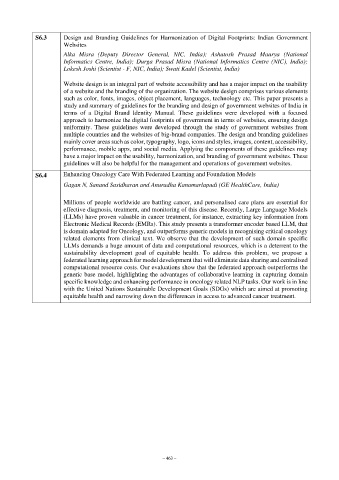Page 507 - Kaleidoscope Academic Conference Proceedings 2024
P. 507
S6.3 Design and Branding Guidelines for Harmonization of Digital Footprints: Indian Government
Websites
Alka Misra (Deputy Director General, NIC, India); Ashutosh Prasad Maurya (National
Informatics Centre, India); Durga Prasad Misra (National Informatics Centre (NIC), India);
Lokesh Joshi (Scientist - F, NIC, India); Swati Kadel (Scientist, India)
Website design is an integral part of website accessibility and has a major impact on the usability
of a website and the branding of the organization. The website design comprises various elements
such as color, fonts, images, object placement, languages, technology etc. This paper presents a
study and summary of guidelines for the branding and design of government websites of India in
terms of a Digital Brand Identity Manual. These guidelines were developed with a focused
approach to harmonize the digital footprints of government in terms of websites, ensuring design
uniformity. These guidelines were developed through the study of government websites from
multiple countries and the websites of big-brand companies. The design and branding guidelines
mainly cover areas such as color, typography, logo, icons and styles, images, content, accessibility,
performance, mobile apps, and social media. Applying the components of these guidelines may
have a major impact on the usability, harmonization, and branding of government websites. These
guidelines will also be helpful for the management and operations of government websites.
S6.4 Enhancing Oncology Care With Federated Learning and Foundation Models
Gagan N, Sanand Sasidharan and Anuradha Kanamarlapudi (GE HealthCare, India)
Millions of people worldwide are battling cancer, and personalised care plans are essential for
effective diagnosis, treatment, and monitoring of this disease. Recently, Large Language Models
(LLMs) have proven valuable in cancer treatment, for instance, extracting key information from
Electronic Medical Records (EMRs). This study presents a transformer encoder based LLM, that
is domain adapted for Oncology, and outperforms generic models in recognising critical oncology
related elements from clinical text. We observe that the development of such domain specific
LLMs demands a huge amount of data and computational resources, which is a deterrent to the
sustainability development goal of equitable health. To address this problem, we propose a
federated learning approach for model development that will eliminate data sharing and centralised
computational resource costs. Our evaluations show that the federated approach outperforms the
generic base model, highlighting the advantages of collaborative learning in capturing domain
specific knowledge and enhancing performance in oncology related NLP tasks. Our work is in line
with the United Nations Sustainable Development Goals (SDGs) which are aimed at promoting
equitable health and narrowing down the differences in access to advanced cancer treatment.
– 463 –

